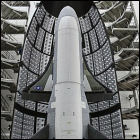X-37B OTV-1
 In a launch simply designated USA-212, the U.S. Air Force launches the Boeing-built X-37B unmanned vehicle into Earth orbit. Resembling a scaled-down Space Shuttle, the X-37B is launched via an Atlas V rocket, though during launch it is fully surrounded by an aerodynamic shell rather than being side-mounted to its booster like the manned Shuttle. The X-37B does not return until December, using a landing profile similar to that of the Shuttle (but automated), and the details of the mission remain classified.
In a launch simply designated USA-212, the U.S. Air Force launches the Boeing-built X-37B unmanned vehicle into Earth orbit. Resembling a scaled-down Space Shuttle, the X-37B is launched via an Atlas V rocket, though during launch it is fully surrounded by an aerodynamic shell rather than being side-mounted to its booster like the manned Shuttle. The X-37B does not return until December, using a landing profile similar to that of the Shuttle (but automated), and the details of the mission remain classified.

 The U.S. Air Force launches a second unmanned X-37B spacecraft into Earth orbit atop an Atlas V rocket. Designated USA-226, this is the second Boeing-built X-37B to reach orbit, and is the first to remain in orbit for over a year, re-entering the atmosphere and successfully conducting an automated landing in June 2012. This X-37B also features a solar panel array that is deployed from its cargo compartment, allowing it to generate constant power during its classified 15-month mission.
The U.S. Air Force launches a second unmanned X-37B spacecraft into Earth orbit atop an Atlas V rocket. Designated USA-226, this is the second Boeing-built X-37B to reach orbit, and is the first to remain in orbit for over a year, re-entering the atmosphere and successfully conducting an automated landing in June 2012. This X-37B also features a solar panel array that is deployed from its cargo compartment, allowing it to generate constant power during its classified 15-month mission. Loaded into an aerodynamic shroud atop an Atlas V rocket, the U.S. Air Force launches the X-37B unmanned spacecraft into Earth orbit. Originally scheduled for an October launch, the Boeing-built X-37B resembles a scaled-down Space Shuttle. Whereas this vehicle had previously stayed in space for several months in 2010 before returning, its second flight sees it remain in orbit for nearly two years, not coming in for an automated landing until October 2014. Details of the vehicle’s mission and payload remain classified; the flight is designated USA-240.
Loaded into an aerodynamic shroud atop an Atlas V rocket, the U.S. Air Force launches the X-37B unmanned spacecraft into Earth orbit. Originally scheduled for an October launch, the Boeing-built X-37B resembles a scaled-down Space Shuttle. Whereas this vehicle had previously stayed in space for several months in 2010 before returning, its second flight sees it remain in orbit for nearly two years, not coming in for an automated landing until October 2014. Details of the vehicle’s mission and payload remain classified; the flight is designated USA-240. The second Boeing X-37B unmanned spacecraft, last flown in 2011-2012, returns to orbit atop an Atlas V rocket. Operated by the U.S. Air Force, the X-37B stays in orbit for just a few days shy of two years, performing classified military tasks as well as research for NASA, and it is capable of re-entering the atmosphere and gliding to a runway landing, very much like the Space Shuttle, of which it resembles a smaller version. Also deployed along with the X-37B is LightSail, an experimental solar sail test vehicle designed, built, paid for and operated by the Planetary Society, building on solar sail concepts originated by Society co-founder Carl Sagan. In a first, the mission will end on the former space shuttle landing strip at Kennedy Space Center in 2017.
The second Boeing X-37B unmanned spacecraft, last flown in 2011-2012, returns to orbit atop an Atlas V rocket. Operated by the U.S. Air Force, the X-37B stays in orbit for just a few days shy of two years, performing classified military tasks as well as research for NASA, and it is capable of re-entering the atmosphere and gliding to a runway landing, very much like the Space Shuttle, of which it resembles a smaller version. Also deployed along with the X-37B is LightSail, an experimental solar sail test vehicle designed, built, paid for and operated by the Planetary Society, building on solar sail concepts originated by Society co-founder Carl Sagan. In a first, the mission will end on the former space shuttle landing strip at Kennedy Space Center in 2017.